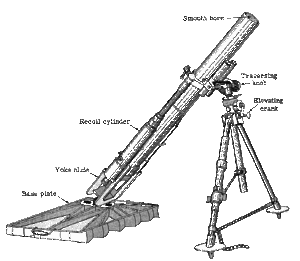Type 94 90 mm infantry mortar
The Type 94 90 mm mortar was a 90 mm smoothbore infantry mortar, introduced in 1935, used by the Japanese in World War II. The Type 94 designation was given to this gun as it was accepted in the year 2594 of the Japanese calendar (1934).[2]
| Type 94 90 mm mortar | |
|---|---|
 Japanese Type 94 90 mm mortar | |
| Place of origin | |
| Service history | |
| Used by | |
| Wars | World War II |
| Specifications | |
| Mass | 159 kg (350.5 lb) |
| Barrel length | 1.27 m (4 ft 2 in) |
| Shell weight | 5.22 kg (11 lb 8 oz)[1] |
| Caliber | 90 mm (3.5 in) |
| Action | Manual |
| Elevation | +45 to +80 degrees |
| Traverse | -29.18 to +26.5 degrees |
| Muzzle velocity | 227 m/s (745 ft/s) |
| Effective firing range | 3.8 km (2.4 mi) |
Design

By giving the Type 94 an especially heavy and stable mount and bipod, a massive shock absorber group, a powerful projectile, and a lengthy tube and heavy powder charge capacity for long range, Japanese designers intended the weapon to serve as a substitute field or artillery piece that could be hauled in pieces to remote locations, a useful attribute for an army short on transport as well as modern towed large-caliber field howitzers and artillery. The Type 94 had a range of some 4000 yards.[3]
Combat record
The Type 94 was encountered throughout the war in China. In the Pacific campaign, it was first used against U.S. forces in the Philippines, and later at the Battle of Guadalcanal. Because of its weight, it was normally employed in static siege or defense situations. Japanese forces sometimes went to great lengths to transport these heavy mortars to remote jungle locations when preparing defensive works.
References
Notes
- Chamberlain, Peter (1975). Mortars and rockets. Gander, Terry. New York: Arco Pub. Co. p. 15. ISBN 0668038179. OCLC 2067459.
- War Department Special Series No 25 Japanese Field Artillery October 1944
- George, John B. (Lt. Col), Shots Fired In Anger, NRA Press (1981), pp. 368-371
Bibliography
- TM E-30-480 at hyperwar.org
- http://www3.plala.or.jp/takihome/
- War Department Special Series No 25 Japanese Field Artillery October 1944